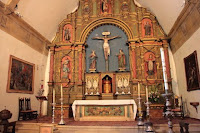The highlight of a trip to Portland, Maine for any photographer has to be the Portland Head Light Station on Cape Elizabeth, because the lighthouse is one of the most photographed in the country.

I had seen some of the spectacular shots of the lighthouse before we left on the trip, so I wanted to get over there as many times as possible to take pictures under varying lighting conditions. This wasn’t much of a problem since our hotel was only 20 minutes from Cape Elizabeth, and the weather during the two days ranged from cloudy and rainy on Saturday morning to bright and sunny (and windy) on Sunday afternoon.

Moon over Portland Head Lighthouse (Click on photo for info)
According to a number of sources, the lighthouse has an historic past. George Washington engaged two masons from the town of Portland in 1787, while Maine was still part of the colony of Massachusetts, and instructed them to take charge of the construction of a lighthouse on Portland Head. They were Jonathan Bryant and John Nichols.

The tower was completed during the year 1790 and first lighted January 10, 1791. The old tower, built of rubblestone, still stands as one of the four colonial lighthouses that have never been rebuilt. Today Portland Head Light stands 80 feet above ground and 101 feet above water, its white conical tower being connected with a dwelling. Henry Wadsworth Longfellow, a native of Portland, often visited the Portland Head Lighthouse and was friends with the keepers. It is believed he received inspiration at the lighthouse for his 1849 poem, The Lighthouse.

Clouds over Portland Head Lighthouse (Click on photo for info)
Portland Head Lighthouse sits majestically on the rocky Maine coast adjacent to Fort Williams Park. The park is a popular destination for picnicking, barbecuing, hiking, all types of sports, and spectacular views of the ocean. Kids love exploring the remains of the old abandoned fort and battery on the grounds. It’s a great place to spend a Sunday afternoon. I understand it’s also a great place in the winter for cross-country skiing, sledding, and ice skating. The lighthouse itself is not open to the public, but there’s a small museum and gift shop attached. The beauty of photographing this lighthouse is that you can shoot from so many different angles and elevations.

Portland Head Lighthouse in the Fall (Click on photo for info)

Portland Head Lighthouse (Click on photo for info)
On our drive from Plymouth, Massachusetts up to Portland, Maine, we took a side trip to the scenic fishing village of Rockport, Massachusetts, which will be the subject of my next post.
If you have a chance, please check out my ImageKind Galleries and Flickr Collections.
 During the first half of our recent trip to New England, we visited the
During the first half of our recent trip to New England, we visited the  Traditionally, Plymouth Rock is said to be the disembarkation site of the Pilgrims. However, there is no historical evidence to support this theory. The first identification of Plymouth Rock as the actual landing site was made in 1741 by 94-year-old Thomas Faunce, whose father had arrived in
Traditionally, Plymouth Rock is said to be the disembarkation site of the Pilgrims. However, there is no historical evidence to support this theory. The first identification of Plymouth Rock as the actual landing site was made in 1741 by 94-year-old Thomas Faunce, whose father had arrived in  The Mayflower II is a full-size replica of the Mayflower, the ship which brought the Pilgrims to
The Mayflower II is a full-size replica of the Mayflower, the ship which brought the Pilgrims to 























